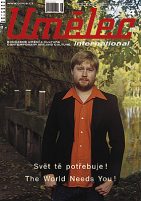| Revista Umělec 2001/4 >> Their Fantasy (My reality, Brooklyn Museum of Art, NY) | Lista de todas las ediciones | ||||||||||||
|
|||||||||||||
Their Fantasy (My reality, Brooklyn Museum of Art, NY)Revista Umělec 2001/401.04.2001 Františka a Tim Gilman-Ševčík | reviews | en cs |
|||||||||||||
|
My Reality: Contemporary Art and the Culture of Japane-se Animation, Brooklyn Museum of Art, New York, 28 July – 7 Oct. 2001
This traveling exhibition investigates the influence anime has had on high art, not just inside of Japan, but around the world. Among the 18 artists showing sculpture, video, painting and photography, only eight are actually from Japan. The work of the native Japanese artists who grew up surrounded by a barrage of anime seems to have a different quality than that of the foreign artists who are alleged to have been influenced by it. The Japanese artists include well-known players like Takashi Murakami, Yoshitomo Nara and Mariko Mori, as well as lesser-known names like Momoyo Torimitsu, Taro Chiezo, Miko Kato, Kenji Yanobe, Mr., and Korean artist Lee Bul. As participants in culture, they have extended the visual language, at times literally creating characters such as Murakami’s DOB creature. The Mickey Mouse-inspired DOB has adventures that are depicted in sculpture, painting, and merchandise, much like the famous Hello Kitty character. Torimitsu manifests one fundamental element of anime: kawaii, or cuteness, with her twin gargantuan inflatable pink rabbits entitled “Somehow I Don’t Feel Comfortable.” Despite the unfortunate installation, which makes them look like oversized toys instead of the oppressive gargoyles they were meant to be, her bunnies take the Japanese infatuation with the cute and innocent (which sometimes seems to border on child pornography) to an unexpected extreme. But for the Japanese, the language is theirs to contort, expand, or exalt, and because anime or super flat culture exists on so many levels, it accommodates and incorporates these gestures into its expanding boundaries. In contrast, the artists from the U.S. and Europe borrow more formal elements. The paintings of Inka Essenhigh or James Esber are examples of this. Miltos Mantes actually appropriates anime-inspired video games Tomb Raider and Soul Blade to make videos in which heroines combine aggressive success with emotional sensibility. A female warrior slays her male opponent over and over again, each time saying, “I’ll never forget you” or “I’m sorry.” But the work the Westerners exhibit doesn’t seem to actually belong in the world of anime. Though some may meet the formal requirements, they do not feel super flat. They remain for now, like the exhibition viewer, outside of a fascinating foreign culture.
01.04.2001
Artículos recomendados
|
|||||||||||||








Comentarios
Actualmente no hay comentariosAgregar nuevo comentario